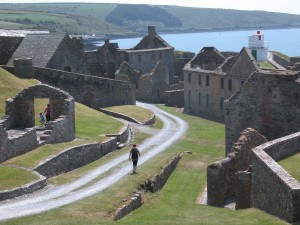PART II
Last month I introduced my driving adventure in Ireland with my daughter while she was studying there for the summer. I had requested a car with an automatic transmission, and the good people at the car rental office gave me the biggest car — a Mercedes — I had seen in that country. The reason my heart sank was that everything I read about driving in Ireland involved narrow roads, near-death experiences when encountering tour buses or trucks, tiny parking spaces, and neighborhoods with streets made for pedestrians and horses, not for hummers.
Plus, I used to own a car like this – a much older version. It was a Mercedes 500 SEL, which my mechanic dubbed The Exxon Valdez, because of both its size and the amount of oil it left wherever it sat. It was a car made for the autobahn, not for avoiding sheep, goats and bicycles on narrow country roads.
I could tell that the rental car man was confused by my lack of enthusiasm, but he was still convinced that this was my dream come true.

We pulled out of the lot, I remembered what side of the road to drive on, and we headed for Kinsale. With my adult daughter on the left, in the passenger side, it felt as if we were doing reverse driver’s training.
“Dad – you’re too close to this bike on the left.”
But if I moved right, even a little, I risked running off the road.
“Dad – you’re almost off the shoulder over here. Dad – you turned into the wrong lane.”
But my favorite was:
“Dad! STOP!”
She said that when the road narrowed so much that it was impossible for two-way traffic to proceed. Someone had to give. Might as well be Sinatra and his daughter in the limo. She also said it one time when we thought we were on a road but turned out to be a pedestrian-only walkway. The pedestrians had to move out of our way twice – once when we nearly ran them over, and again when I had to traverse the same path in reverse.
Kinsale is one of the most beautiful towns I have ever seen. It reminded me of that English village in the British television series Doc Martin, blindingly bright houses and their blue, red, orange and green doors, all built on a ledge overlooking the harbor. American friends warned me about how bland the food was in Ireland, but the seafood chowder at Dino’s right along the water is the best I’ve ever tasted.
We walked through the Desmond Castle, which was built in the 1500s. It had been used as a residence, a fort, wine cellar and

even a prison for Americans during the Revolutionary War. It’s now a museum surrounded by residences and Bed and Breakfasts. One could walk past it and not even notice. Another ancient establishment, the Charles Fort, is harder to miss. It is spread out for hundreds of yards in all directions like spokes on a massive stone wheel, with Kinsale in the background and the harbor in the foreground.
A day later we headed toward Cobh, another seaside town we’d heard about. The young lady at the tourist office in Kinsale showed us how to get there on a printed map, but then, with a pen and a still smoldering cigarette in the same hand, she drew us her own map, showing us a shortcut to a ferry, which she said would get us across the river and into Cobh in a fraction of the time. Seemed reasonable, we thought.
The problem was we couldn’t really figure out her map. We got to the town she recommended, but Vanessa and I disagreed on what she told us to do once we got there. Nothing looked promising, and both of us got that hot, annoyed feeling people get when they’re lost in a foreign country on the left side of the road with a car that’s forcing traffic oncoming traffic onto the sidewalk

because now we’re too agitated to be polite.
At last we saw a sign with a picture of a ferry on it. All was forgiven. We loved this country again, and the Kinsale tourist helper and her second-hand smoke wasn’t so bad after all. We kept with the traffic being directed by the ferry signs, and then finally got into a line of hundreds of cars. It struck me as strange to be in such a lengthy queue (see how quickly I adapted to Europe’s quaint vocabulary?), because the impression I got from the Kinsale helper was that this was a small river ferry. Still, Cobh was a popular tourist destination, and it was summer, and the weather was spectacular (whoever said it rained all the time was crazy!), so we patiently stayed in line with the traffic and listened to Vanessa’s travel playlist on her ipod.
After 40 minutes or so we pulled up to the kiosk.
“Passports?” said the brisk uniformed woman.
“They’re in the trunk – I mean the boot – of the car,” I said. “I didn’t think I’d need them.”
I put the car in Park so I could retrieve the documents. But something seemed off.
“Why do I need my passport?”
A broad smile spread across her face. I couldn’t tell if it was kindness, amusement or condescension.
“Where do you think you’re going?” she asked brightly.
“Cobh,” Vanessa and I said in unison.
The woman’s smile got even brighter, and her eyebrows reached into her forehead.
“You’re going to France!”
END OF PART II